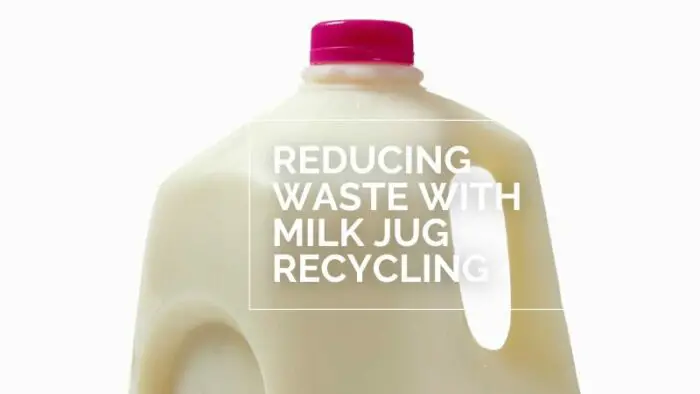Yes, milk jugs can be recycled. However, it is essential to prepare them for recycling properly. First, empty the milk jug and rinse it thoroughly to remove any residue. Next, remove the cap and recycle it separately, as it is often made of a different type of plastic. Finally, flatten the milk jug and recycle it with other plastic bottles and containers.
Milk jugs, like other plastic containers, are made from a type of plastic called polyethylene terephthalate (PET). PET is a strong and lightweight material commonly used for packaging food and beverages. It is also easily recyclable, and many recycling programs accept milk jugs as part of their plastic bottle and container recycling streams.
Recycling milk jugs help to conserve natural resources and reduce waste. When plastic bottles and containers are recycled, they are melted down and made into new products, such as carpets, clothing, and plastic lumber. Recycling milk jugs also reduces the amount of plastic in landfills, where it can take hundreds of years to decompose.
Recycling milk jugs is essential in protecting the environment and conserving natural resources. By adequately preparing and recycling milk jugs, we can all play a part in reducing waste and protecting the planet.
Getting Milk Jugs Ready for Recycling
To properly prepare milk jugs for recycling, follow these steps:
- Empty and rinse the milk jug: Empty it and rinse it thoroughly to remove any residue. This will help to prevent contamination of other materials in the recycling stream and ensure that the milk jug is recycled correctly.
- Remove the cap: The cap on a milk jug is often made of a different type of plastic, so it should be removed and recycled separately.
- Flatten the milk jug: Squashing the milk jug will help to save space in the recycling bin and make it easier to transport to the recycling facility.
- Recycle with other plastic bottles and containers: Once the milk jug is prepared correctly, it can be recycled in the recycling bin with other plastic bottles and containers.
By properly preparing milk jugs for recycling, you can help to ensure that they are properly recycled and repurposed into new products, such as carpets, clothing, and plastic lumber. This helps to conserve natural resources, reduce pollution, and protect the environment.

Uses for Old Milk Jugs
There are many creative and practical ways to reuse milk jugs:
- Gardening: Milk jugs can create a mini greenhouse for seedlings or protect plants from frost. Cut the bottom off the jug and place it over the plant, securing it with a rubber band or soil.
- Watering can: Cut the top off a milk jug and use it as a watering can for plants or seedlings.
- Storage container: Milk jugs can store small items such as screws, nails, or seeds.
- Ice pack: Fill a milk jug with water and freeze it to create a reusable ice pack for a cooler or injury.
- Bird feeder: Cut a small hole in the side of a milk jug and fill it with birdseed. Hang it up in a tree to create a simple bird feeder.
- DIY sprinkler: Punch holes in the sides of a milk jug and attach a hose to the spout. Turn on the water, and the jug acts like a DIY sprinkler.
- Craft material: Milk jugs can be cut and shaped into various crafts, such as birdhouses, plant pots, or toys.
By reusing milk jugs, you can reduce waste and save money on purchasing new items. It’s also a great way to get creative and have fun while helping the environment.
What Happens to Milk Jugs that Make it to the Land Fill?
When milk jugs end up in a landfill, they can take hundreds of years to decompose. Landfills are designed to prevent the escape of waste, so there is little oxygen and moisture present, which slows down the decomposition process. As a result, milk jugs and other types of plastic can remain in landfills for a very long time, potentially hundreds of years.
In addition to taking up space in landfills, plastic waste can also have negative environmental impacts. When plastic breaks down, it can release harmful chemicals into the soil and water, negatively affecting plant and animal life.
To reduce the amount of plastic waste in landfills, it is essential to recycle milk jugs and other types of plastic. Recycling helps to conserve natural resources, reduce pollution, and protect the environment. By properly preparing and recycling milk jugs, we can all play a part in reducing waste and protecting the planet.
Conclusion
In conclusion, milk jugs are made from a type of plastic called polyethylene terephthalate (PET) and can be recycled as part of the plastic bottle and container recycling stream.
Recycling milk jugs help to conserve natural resources, reduce pollution, and protect the environment. To properly prepare milk jugs for recycling, it is important to empty and rinse them out, remove the cap, flatten the jug, and recycle it with other plastic bottles and containers. In addition to recycling, milk jugs can be reused in various creative and practical ways, such as gardening, storage, and DIY projects.
By properly recycling and reusing milk jugs, we can all play a part in reducing waste and protecting the planet.

